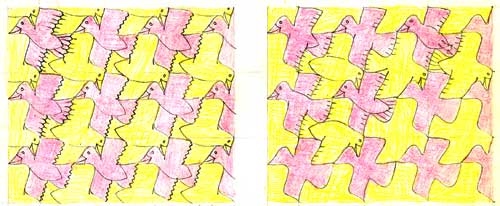Introduction An essentially additional aspect of tessellation possibilities is that of the serration of certain lines, undertaken for the purposes of improvement of motif, this being dependent on circumstance. This mostly and arguably more naturally, applies to birds and to a lesser extent other motifs, such as fish, horses, bugs and wild boars. More exactly upon having designed a motif, e.g. a bird of a given outline, it is possible, albeit dependent on circumstance, to introduce this feature. This essay examines the issues underlying this feature. Also, I examine Escher’s usage, my own, and Makoto Nakamura’s usage of such a device, of which the latter uses this feature the most extensively. As such, this feature should be looked upon as an innovation, rather than assuming any undue importance, as it is of a secondary aspect to the tessellation. Broadly, it arises as a by product, in that having designed the tessellation, it is then possible to add this feature. In essence, it offers an optional extra if so desired. However, this device, if used at all, must be used appropriately, as it is not suitable in all instances, due to the symmetry arrangement of the tessellation, as this may not be compatible with the tessellation, and so have to be ruled out. To examine the issue, this is addressed with an examination of the suitable motifs. When creating tessellations, the primary aim is, or should be, to have the outline of motif as recognisable as possible to the creature it is purporting to represent. Wherever possible, if the tessellation will admit it, fine detail, such as serrations, e.g. as occur with a bird’s wing should be added, thus aiding recognition of the motif. Motifs Bird Background Upon examining a real life bird, it can be seen that the wing is formed of a series of serrations, as shown below Insert pic This feature can also be seen to be of the tail as well. Insert pic Fish Horses Although
a horse may seem at prima facie an unsuitable motif, as it main outline has no
natural serrations, it is possible to contrive a situation where it does,
namely with its tail and mane flowing. Bugs Usage by Other People M.C. Escher’s Usage of Serration As can be seen by an examination of the 137 periodic drawings, Escher, where the possibility existed, frequently used this feature, of approximately on half the occasions. 32, Fish, 1940 (with reservation)
Although it may appear that other of his tessellation are suitable, this is not so. For example, No.106 has a upper rear wing line that shares a border with the head and beak. Therefore, if the wing was serrated, this would affect the head, giving a most unlikely appearance, to the overall detriment of the tessellation. Therefore, in this instance, serration would not be selected for usage. Therefore, the opportunities for this feature are somewhat limited. Makoto Nakamura Bird 1 Bird 3 David Bailey Figure 1 It is thus possible to introduce this concept on the
appropriate occasion, as shown, with
a semi-neat study, Figure 1, right, a bird with no serrations; and left, of a
serrated motif of the bird at right. In this instance, it is of types (a) and
(c). The above diagram shows some experiments undertaken on a geometric bird, of type (a) where wings meet. Above
I show some further examples, of a more stylised nature, of a geometric
type of motif. Firstly, I show various experiments that are undertaken in the
pursuit of a best type. Note that as I have identical birds, so must the birds
with serration to be consistent. To achieve this, the serrated line must be 180° rotational. Again, the purpose is
one of discerning the best serration, rather than simply settling for the
first, as so many other people seem to do. As I state in my other essays,
quality of motif is everything! experiments Best serration, as a semi-neat wireframe As such, tessellations pay lip service to this feature, in that such a feature is not generally applicable, although desirable. To workaround this, they put in place a series of lines, of which therefore this feature is implied. Below I show a diagram where this feature is implied. Summary Agree/disagree? E-me. Created: 14 September 2009 |
